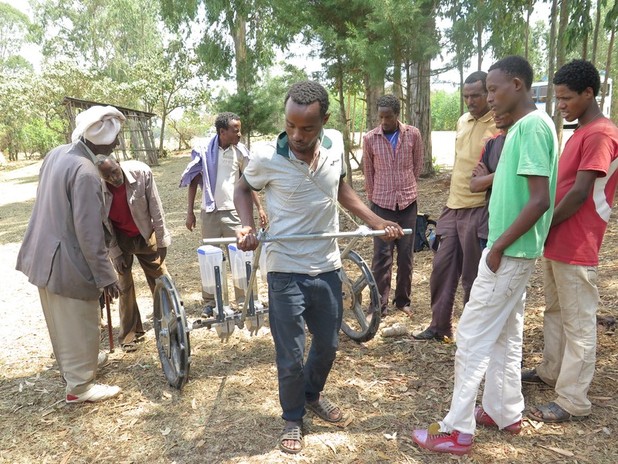May 20, 2014
Back from their most recent prototyping trip to the field, the IDEO.org team—working with the Ethiopian Agricultural Transformation Agency on building a teff row planter—gains some important feedback from farmers.
During our trip, we managed to squeeze in three days of interviews with farmers to get feedback on our planter prototype, and as always we learned a ton. We were also tasked with interviewing potential manufacturers to get a grasp on how to design the planter with local manufacturing in mind, but I’ll leave those details to another post. With limited time, we split the team up to cover as much ground as possible.
On the first day Martin went back to our good friend and fellow innovator, Fituma, to show him what we came up with. Before the planter was even off the truck he began his critique. He and a group of local farmers went through the planter system by system telling Martin what they thought would and wouldn’t work. In no time they had started to prototype solutions to problems we hadn’t even thought of, and by the end of a couple hours they had a potential attachment for oxen (complete with some role playing) as well as a harness system to help make the planter more comfortable to carry. They also pointed out some key things to consider about transporting the planter resulting in changes to make it easier to lift and move.
The next day, Ravi took off solo for a second interview. Following Martin’s recruitment method, he literally pulled over to the side of the road wherever farmers happened to be congregated and asked them to test our prototype. The planter always draws a lot of attention, so what might start as a two-farmer interview quickly turns into a small crowd. With the help of our amazing translator, Ibraham, Ravi managed to dig a bit deeper on critical issues like cost and training. Though farmers would prefer to own the planter on their own, they would be willing to own it as a group or rent it out if the cost were too high (similar to how they use oxen). The overwhelming consensus about training was that a quick training day would be necessary to use the device properly. Men historically throw away the instruction manual so hearing such a strong call for training was a great surprise, but very understandable since their food literally relies on it.
For the last day of interviews, the team reconvened. As our convoy rolled down the road avoiding sheep and cows, we continued to pull over at any shady tree with farmers under it. I finally got to try my hand at being a researcher and got to see how some of the mechanisms were holding up under scrutiny of the end user. Though the ratchet wasn’t always immediately understood, it was a huge hit from a practicality standpoint. Farmers had concerns about dispensing seed and fertilizer when not desired, for example when turning around or moving the planter to the field, so they appreciated the ability to turn it on and off.
Spare parts were another major concern. Though the planter is simple compared to mechanized farm equipment, it would still be one of the more complicated and expensive thing to own. Farmers knew that if they placed their livelihood in the hands of this planter, they would need to have easy access to spare parts. This was a great piece of insight because it has pushed us to think carefully about two things—incorporating pieces that are readily available locally and ensuring that farmers have the proper distribution network for them to easily find parts for repairing their planter.
In short, we identified several takeaways:
· Farmers want to row plant, but manually doing so takes too long. They want a device because it would save them time.
· Cost is a major concern. Farmers want to own it on their own ideally, but would be willing to share if the cost is too high to incur alone.
· Training is a must. Even though most of the farmers already know about row planting, they would want to know how to use the planter, and how to maintain it. The planter would be one of their most expensive possessions, so they want to know they are using it well.
· Proof is in the productivity. They want to know it works since they are mainly subsistence farmers who rely on their crops as a basic food source. A lot of farmers wanted to see test plots.
· (And one more for those considering a visit to Ethiopia) Avoid the traffic circles. Ibraham got to learn some “colorful” English words to describe the ensuing traffic nightmare.







